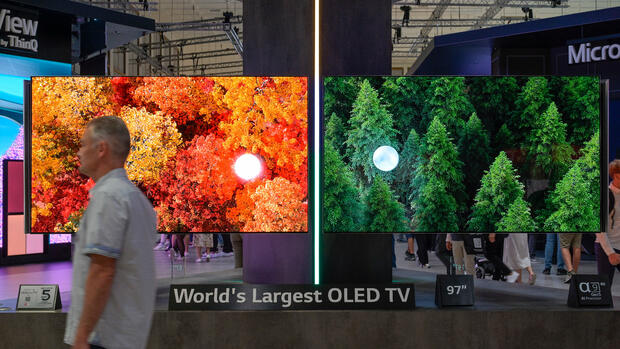The South Korean group is the world market leader for these large screens.
(Photo: IMAGO/Schöning)
Tokyo Ferrari becomes the symbol of the battle between two Korean tech giants. Samsung Display announced this week that it would supply OLED screens to the Italian sports car brand alongside Hyundai and Audi. These are to be installed in the Ferrari models of the next generation.
For Samsung, this is another notable success in its strategy to compete with arch-rival LG to become the undisputed market leader in these displays – with potentially negative financial consequences.
Displays made of organic light-emitting diodes, or OLEDs for short, have long been regarded as important competitors to liquid crystal displays (LCDs) for monitors where particularly deep black is important, such as in smartphones or high-quality televisions. Unlike LCDs, OLEDs do not require a backlight. They therefore not only deliver high-contrast, brilliant images, but can also be made thinner and better shaped into curved displays.
For a long time, Samsung suffered from a particularly painful shortcoming: South Korea’s largest group dominated the world market for small OLED displays for smartphones and tablets. Ten years ago, however, Samsung had to leave the field to its smaller competitor when it came to the prestigious OLED televisions of all things. LG controls 60 percent of the world market for OLED TVs.
The problem: Samsung’s production process simply generated too much waste to produce large screens at a competitive cost. But now the group wants to know again: With new OLED televisions, it is attacking LG head-on.
In the weekly column we take turns writing about innovation and economic trends in Asia.
(Photo: Klawe Rzeczy)
Last year, Samsung had already launched two smaller models with screen diagonals of 55 and 65 inches. The previous flagship model with a 77-inch screen followed at home in Korea. Even more: At the beginning of April, Samsung announced that it would build a new OLED factory in South Korea by 2026 for 4.1 trillion won – the equivalent of 2.8 billion euros – in order to become the world market leader in all display categories.
South Korea’s opposition to ‘creative destruction’
South Korean President Yoon Suk-Yeol welcomed the expensive factory, which is expected to create 26,000 jobs. “Today’s signing of the new massive investment plan is another leap forward for the country’s display industry,” said Yoon. “In order to achieve innovation and growth, bold investments in value-added industries such as high-tech are necessary.”
The jubilation is understandable. South Korea’s government and companies refuse to allow even barely profitable industries to migrate freely according to the concept of “creative destruction”. This idea of the Austrian economist Joseph Schumpeter of the renewal of capitalism through the decline of old and the emergence of new industries shaped the West for a long time. But South Korea wants to defend its industrial base with all its might.
The government of South Korea wants to further expand its role as an exporter of batteries, chips and electronics with high investments and state subsidies. After the chip and car industry, which has been highly profitable for a long time, the display industry is the third largest area. Car batteries and robots follow.
Other columns in the Asia Technonomics series:
Rival LG is also happy – at least officially – about Samsung’s return to the market. “We welcome the entry of a competitor into the OLED TV market because it can increase the size of the market,” a manager told Korean media, setting out the regulatory correct line.
Investors, on the other hand, should have less reason to be happy. Even now, the corporations hardly earn any money with screens, if they don’t actually lose some. According to analyst estimates, LG Display is said to have made a profit again at the beginning of the year after three loss-making quarters.
Samsung’s displays are not among the profit engines either. The group’s past fabulous profits were generated by the chip division, which slipped deep into the red in the first quarter.
The fact that Samsung is now also entering the market for OLED televisions in addition to Chinese companies such as BOE should not improve the prospects. Competition may stimulate business, but not necessarily corporate profits.
In the Asia Techonomics column, Nicole Bastian, Sabine Gusbeth, Dana Heide, Martin Kölling and Mathias Peer take turns writing weekly about the most exciting technological and economic trends in the world’s most dynamic region.
More: The 215 billion project – How South Korea wants to expand its semiconductor industry into a world empire.
